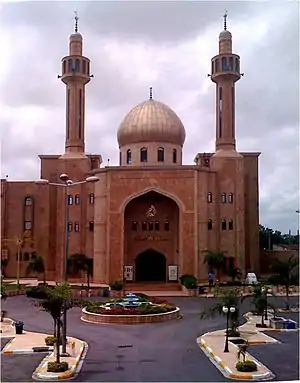Islam in Ivory Coast
Islam was the first Abrahamic monotheistic religion to arrive in Ivory Coast. Today, it is the most widely professed religion in the country, representing 60 percent of the total population.[1][2]
| Islam by country |
|---|
 |
|
|
As of the late 1980s, only the most devout Muslims in Ivory Coast prayed, fasted, and gave alms as required by strict tenets of Islam, and only the most wealthy performed the hajj.[3] Most Ivoirian Muslims are Sunni, following the Maliki version of Islamic law.[3] Sufism, involving the organization of mystical brotherhoods (Tariqa) for the purification and spread of Islam, is also widespread, laced with indigenous beliefs and practices.[3] The four major Sufi brotherhoods are all represented in Ivory Coast, although the Qadiriya, founded in the eleventh century, and the Tidjaniya, founded in the eighteenth century, are most popular.[3] The Qadiriya is prevalent in the west, and the Tidjaniya, in the east. The other two major Islamic brotherhoods have few adherents in Ivory Coast.[3] The Senoussiya is identified with Libya, where its influence is substantial.[3] Ahmadiyya movement is also present in Ivory Coast.[3]
The significant religious authority is the marabout.[3] He is believed to be a miracle worker, a physician, and a mystic, who exercises both magical and moral authority.[3] He is also respected as a dispenser of amulets, which protect the wearer—Muslim or non-Muslim—against evil.[3] The influence of marabouts has produced a number of reactions in Ivoirian society, among them a series of reformist movements.[3] These reform movements often condemn Sufism and marabouts as un-Islamic, but the poor see that marabouts often speak out on behalf of the downtrodden.[3]
Hamallism began as an Islamic reform movement in the French Sudan early in the twentieth century and has provided a channel for expressing political and religious discontent.[3] Its founder, Hamallah, was exiled from the French Sudan to Ivory Coast during the 1930s.[3] He preached Islamic reform tempered by tolerance of many local practices, but he condemned many aspects of Sufism.[3] Orthodox brotherhoods were able to convince the French authorities in Ivory Coast that Hamallah had been responsible for earlier political uprisings in the French Sudan.[3] Authorities then expelled Hamallah from Ivory Coast and banned his teachings.[3]
The massive immigration of Muslims from the Muslim majority countries Burkina Faso and Mali helped to increase the number of Muslims substantially.
According to Pew Forum the population of Shia in Ivory Coast is less than one percent of the total Muslim population of Ivory Coast[4] while as per Imam Husayn (as) Encyclopedia the population of Shia in Ivory Coast is around five percent of the total Muslim population of Ivory Coast.[5]
See also
References
- "Ivory Coast". Global Religious Futures. Pew Research Center. Retrieved 1 July 2021.
- "The World Factbook — Central Intelligence Agency". www.cia.gov. Archived from the original on 9 January 2021. Retrieved 16 April 2018.
- Byrnes, Rita M. (1988). "World religions". In Handloff, Robert Earl (ed.). Cote d'Ivoire: a country study. Washington, D.C.: Federal Research Division, Library of Congress. pp. 70–71. OCLC 44238009. Archived from the original on 2021-09-27. Retrieved 2021-08-16.
 This article incorporates text from this source, which is in the public domain.
This article incorporates text from this source, which is in the public domain.{{cite encyclopedia}}: CS1 maint: postscript (link) - "Estimated Percentage Range of Shia by Country" (PDF). Pew forum. Archived from the original (PDF) on 1 August 2012. Retrieved 30 July 2013.
- "Shia Population in: Ivory Coast". The AhlulBayt World Assembly. 8 April 2010. Archived from the original on 6 June 2014. Retrieved 21 November 2013.
